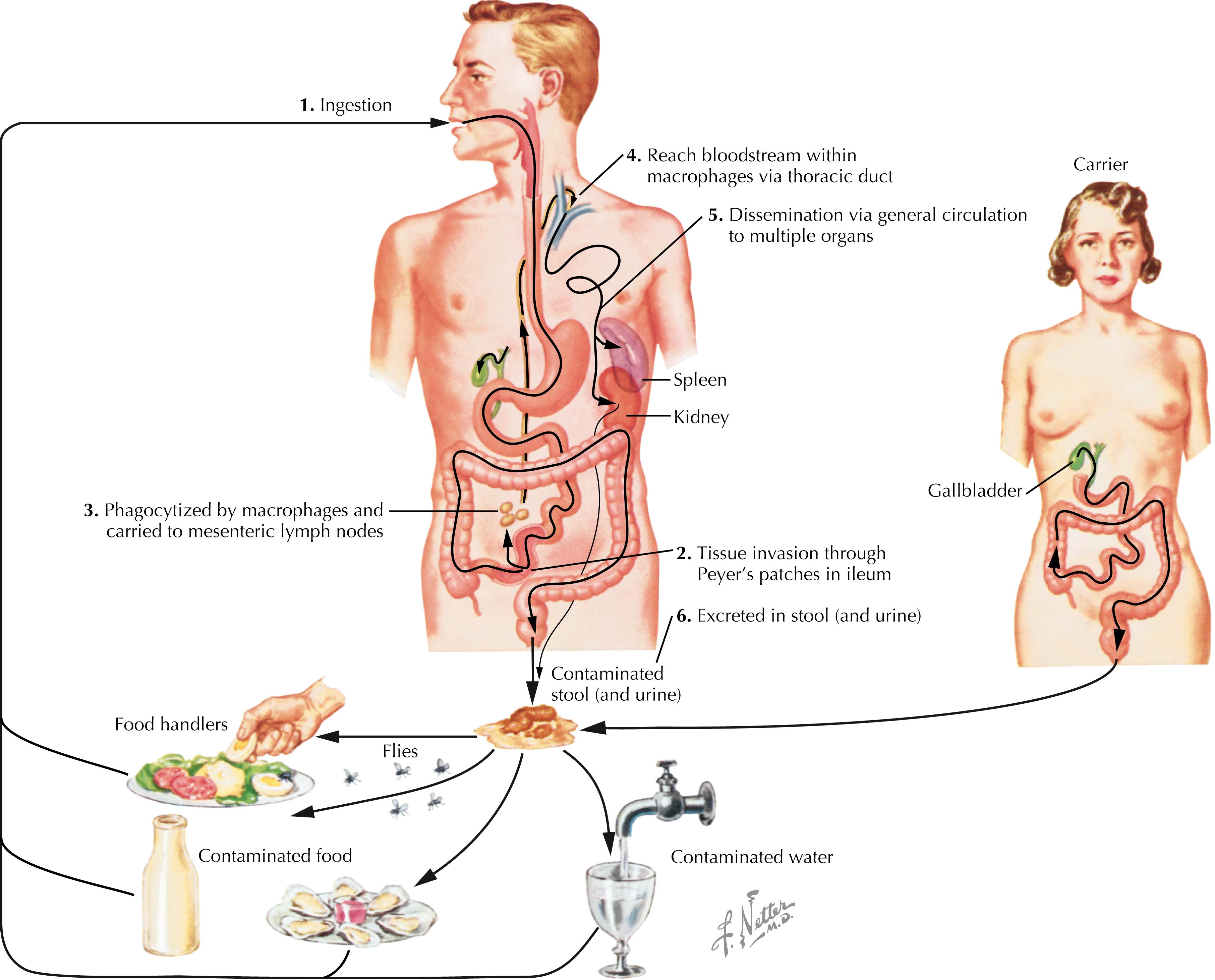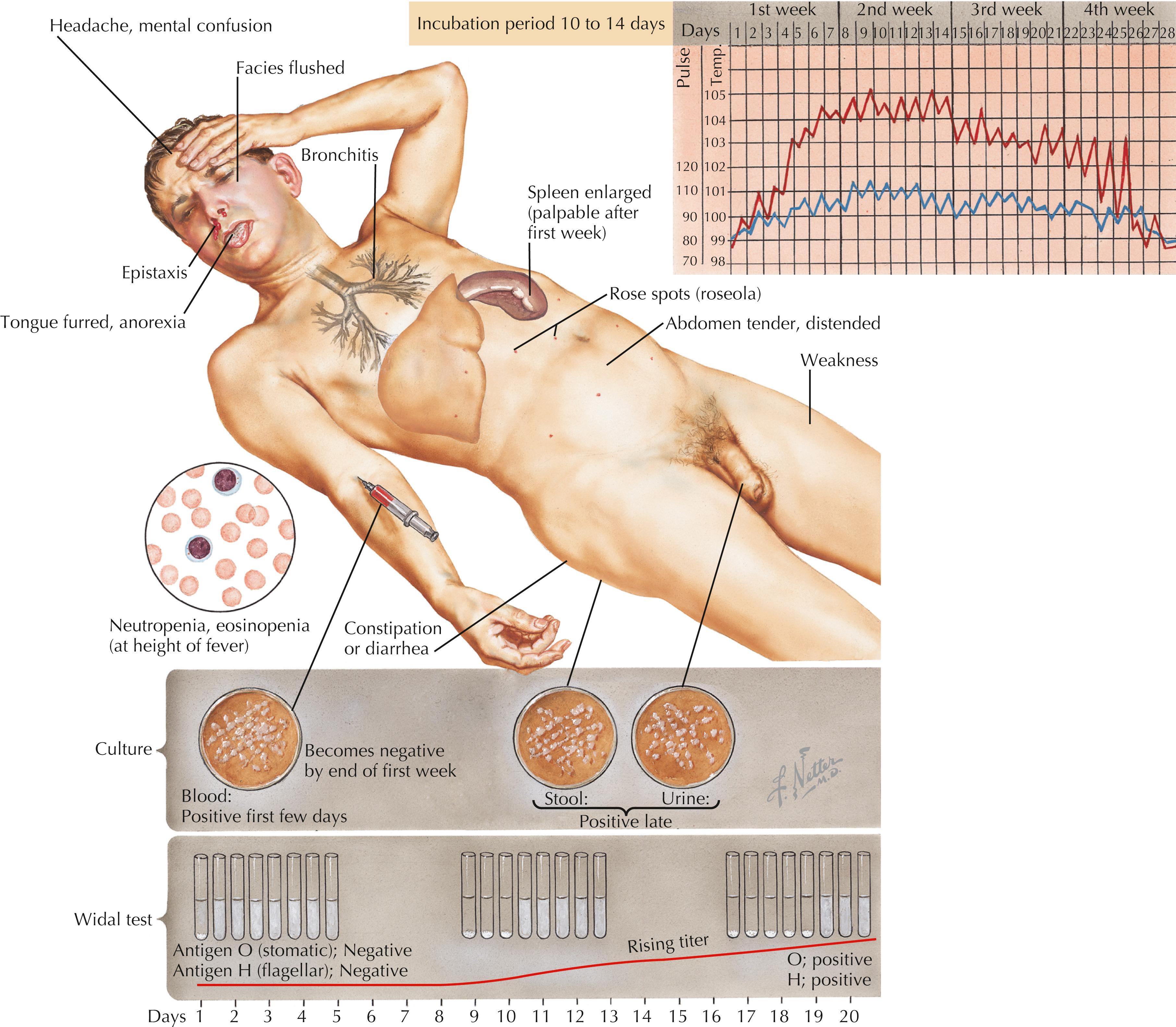Physical Address
304 North Cardinal St.
Dorchester Center, MA 02124
Infection with the gram-negative bacteria Salmonella enterica serotype Typhi ( S . Typhi) or S. enterica serotype Paratyphi A, B, or C ( S. Paratyphi A, B, or C) may result in a serious febrile illness known as enteric fever. The illness is called typhoid fever or paratyphoid fever once the causative agent has been identified. Pathogenic Salmonella bacteria causing invasive disease are a particular problem in parts of the world with poor sanitation and hygiene, as the disease is transmitted by food and water contaminated with human waste. In endemic areas, the estimated number of individuals with enteric fever at any one time may exceed 10 per 100,000 population. Cases reported in the United States, Canada, Western Europe, Australia, Japan, and other industrialized countries are relatively rare—usually acquired by travelers abroad and diagnosed when symptoms become manifest after return home. Enteric fever can be a mild uncomplicated illness with fever, headache, and malaise, or it can develop into a more severe life-threatening illness manifested by prolonged high fever as high as 39°C to 40°C (102°F to 104°F), prostration, hepatosplenomegaly, intestinal hemorrhage or perforation, and altered mental status. Children and older adults tend to experience more serious illness with infection, although persons in all age groups are susceptible. Infections caused by S . Typhi and S . Paratyphi cannot be distinguished from each other based on clinical presentation alone (which may be similar to that of other infectious diseases—such as malaria, dengue, leptospirosis, brucellosis, and typhus—causing fever in endemic regions), although paratyphoid fever tends to be a milder typhoid-like illness. The diagnosis is confirmed by isolation of the organism from blood, stool, urine, or other clinical specimens including bone marrow. The Widal-Felix agglutination reaction is still used as a test for typhoid fever in certain endemic countries but has relatively low sensitivity and specificity and should not be performed before the second week of illness. Rapid diagnostic tests (RDTs) for detecting typhoid with relatively high sensitivity and specificity have become commercially available in several countries where enteric fever is endemic and yield results that are more timely and less labor intensive than culture. Multidrug-resistant (MDR) typhoid strains resistant to chloramphenicol, ampicillin, and cotrimoxazole first appeared in the 1980s. In the 1990s and 2000s S . Typhi and S . Paratyphi strains with decreased susceptibility to fluoroquinolone antibiotics and to some cephalosporins emerged on the Indian subcontinent and in Southeast Asia and Central Asia, making treatment of serious infections more challenging. Among untreated typhoid patients the fatality rate can be as high as 20%. Approximately 5% of those with acute disease become chronic carriers. Efficacious vaccines against typhoid fever are available for the protection of travelers and for mass immunization programs of children residing in highly endemic areas, but a safe and effective vaccine against paratyphoid fever is not currently available.
A 29-year-old graduate student came to the university health center with complaints of fever, headache, stomachache, loss of appetite, and feeling weak over the previous 2 days. He and his wife had just returned a week earlier from a 2-week trip to Mumbai to visit his ailing father, who was in the hospital. The patient stated that he was generally healthy before the onset of his current illness and that the trip to India was unexpected, so neither he nor his wife received any pretravel health advice. His review of systems was remarkable for his report of general malaise, anorexia, diffuse abdominal discomfort, and no bowel movements in the previous 2 days. He denied shaking chills and sweats, stiff neck, photophobia, nausea and vomiting, or change in the color of his urine. Vital signs were blood pressure (BP) 116/78, temperature 103°F, pulse 96, and respiration 20. The patient was an ambulatory but ill-appearing Indian male accompanied by his wife. Physical exam was remarkable for a macular erythematous rash on the trunk that was barely visible against the patient’s natural skin tone; bowel sounds were present and abdominal exam showed mild tenderness to deep palpation in all four quadrants but no enlargement of liver and spleen; rectal exam was unremarkable and the stool guaiac test was negative. Blood samples were drawn for a complete blood count, blood chemistries, malaria smear, and blood cultures. Additional blood was drawn to perform a RDT for malaria, and an extra tube was drawn as an acute serum sample. A urine sample was sent for a urinalysis (UA) and a stool sample was sent for culture of enteric pathogens. The patient and his wife waited in clinic for the initial stat lab results. The blood count and white blood cell differential were within normal limits (WNL), the malaria smear and RDT test were reported negative; glucose, blood urea nitrogen (BUN), bilirubin, and electrolytes were WNL; the UA was normal; and cultures of blood and stool were pending. A presumed diagnosis of typhoid fever was made on the basis of the history of travel to a highly endemic area for enteric fever, the clinical presentation, and the preliminary laboratory results. Another blood sample was sent for culture, and the patient was started on an oral antibiotic regimen of azithromycin 1 g by mouth once daily for 7 days at the advice of an infectious diseases consultant. The patient was discharged to home with arrangements for daily telephone follow-up and a clinic follow-up appointment in 1 week. Three days after his discharge from the clinic, the lab reported that two out of three blood cultures were positive for S . Typhi but the stool culture was negative. The patient reported having no fever and feeling much better by day 4 on treatment. He was instructed to complete his antibiotic course and to return for his follow-up appointment.
Enteric fever is a global public health problem and tends to be highly endemic in countries where inadequate sanitation and hygiene allows for the ready contamination of food and water with human waste. Epidemics of typhoid fever and high endemic disease rates have been reported in India and countries in South Asia, the Middle East, Central Africa, and South America. According to World Health Organization (WHO) estimates, typhoid fever accounts for up to 21 million cases and 161,000 deaths annually worldwide. In industrialized nations, most reported cases occur among returned international travelers, with local outbreaks resulting from contact with asymptomatic carriers. Approximately 350 culture-confirmed cases of typhoid fever and 90 cases of paratyphoid fever caused by S . Paratyphi A per year were reported during 2008–2015 to the Centers for Disease Control and Prevention (CDC) in the United States.
S . Paratyphi A accounts for a substantial number of enteric fever cases among returned travelers from India and countries in South Asia, the Middle East, and East Africa. In India, Pakistan, and Indonesia, an analysis of enteric fever cases published in 2005 showed that S . Paratyphi A had emerged as the causative agent in a growing proportion of enteric fever cases; in China it exceeded S . Typhi as the cause of enteric fever.
Humans are the reservoir for S . Typhi and S . Paratyphi infections, with human-to-human transmission taking place through the fecal-oral route. Drinking water and ingesting raw vegetables and fruits, undercooked shellfish, ice cream, and other food products contaminated by impure water sources or the dirty hands of infected food handlers are the usual sources of infection, although flies landing on infected feces and then on food also contribute to food contamination ( Fig. 67.1 ). Airborne transmission through aerosols during large outbreaks has also been considered a possibility.

Inoculum size influences the severity of an infection, with a large inoculum tending to cause more severe illness after a relatively short incubation period. Host factors associated with higher morbidity include being very young or very old, having lower gastric acidity due to medications (e.g., histamine-2 [H 2 ] blockers, proton pump inhibitors, antacids), or anatomy (partial gastrectomy); immune suppression caused by human immunodeficiency virus infection, cancer chemotherapy, and other conditions or treatments; coinfection with Helicobacter pylori ; and human leukocyte antigen (HLA) tissue type.
After S . Typhi or S . Paratyphi bacteria are ingested in contaminated foods and beverages, the bacteria that survive passage through gastric acidity in the stomach pass in the fecal stream to the small intestine. During invasive disease the bacteria invade the microfold cells (M cells) that overlie the lymphoid tissue (Peyer patches) in the ileum and pass through them into the underlying tissue (lamina propria), where they are phagocytized by macrophages and carried to the mesenteric lymph nodes, where they continue to multiply intracellularly. The bacteria within infected macrophages disseminate in the bloodstream to multiple end organs including skin, spleen, liver, biliary tract, kidneys, and bone, causing multiple foci of infection and inflammation. Fever and prostration are caused by the release of bacterial lipopolysaccharides (LPSs) and other cytotoxic inflammatory mediators ( Fig. 67.2 ).

Become a Clinical Tree membership for Full access and enjoy Unlimited articles
If you are a member. Log in here